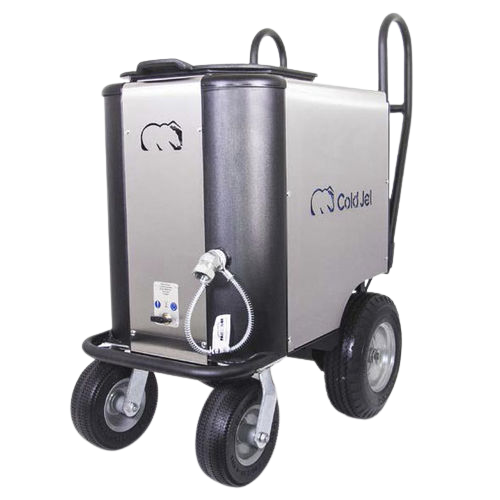Dry Ice Blasting
Dry Ice Blasting Applications
Fin--Fan Cooler Cleaning
Mining Equipment Cleaning
Bitumen Removal
Industrial Tube Cleaning
Mold Remediation
Fire Restoration
Electrical Component Cleaning
About
Smart Technology
Dry ice blasting uses solid carbon dioxide (CO2) pellets — or MicroParticles — blasted at supersonic speeds which sublimate on impact, lifting dust, dirt, and other contaminants off the underlying layer.
Non-abrasive, non-conductive, non-toxic, & non-flammable, dry ice blasting equipment features incomparable technology, used in a variety of applications and functions.
Environmental Facts about Dry Ice Blasting
Did you know?
- Dry ice is non-toxic, non-hazardous and inhibits mold and bacteria growth
- Dry ice blasting is safe to use with food processing equipment
- Dry ice blasting does not generate secondary waste
- Dry ice blasting reduces or eliminates employee exposure to (and corporate liability from) the use of dangerous chemical cleaning agents
Other cleaning methods can be toxic
- Sand, soda, or water blasting can leave toxic secondary waste to be cleaned up and disposed of in addition to the toxic substrate
- Sand, soda, or water blasting can create downstream contamination that effects surrounding installations
- Soda blasting can kill surrounding vegetation
- Workers are exposed to potentially harmful substances through the use of chemicals and solvents
Reclaimed CO2
CO2 Technology Dry Ice Blasting Process
Energy Transfer
Dry ice (CO2) particles are propelled to supersonic speed on to a contaminated surface. The particles are accelerated by compressed air, just as with other blasting methods. The energy transfer cleans the contaminant without abrasion. The force of this impact is the primary means of cleaning.
Micro-Thermal Shock
The cold temperature of the dry ice pellets hitting the contaminant creates a micro-thermal shock (caused by the dry ice temperature of -79º C) between the contaminant and the substrate. Cracking and delamination of the contaminant occurs, furthering the elimination process.
Gas Pressure
In the final phase of blasting, dry ice pellets fracture on impact, and as the particles warm they convert to CO2 gas, which expands rapidly beneath the contaminant. This forces the contaminant off the substrate. With the sublimation of the dry ice, only the contaminant is left for disposal.
Advantages of Dry Ice Blasting
Dry ice blasting can increase profitability through improved productivity, reduced waste and lower costs. Today, dry ice blasting is being effectively used in a wide array of applications from oilfield contaminant removal to delicate semiconductor and circuit board cleaning. Imagine a process that can be used on-line without damaging equipment or requiring a machine “teardown”.
Unlike conventional toxic chemicals, high-pressure water blasting and abrasive grit blasting, dry ice blasting uses dry ice particles in a high velocity air stream to remove contaminants from surfaces without the added costs and inconvenience of secondary waste treatment and disposal.
With a low temperature of -79° C, solid CO2 (dry ice) has an inherent thermal energy ready to be tapped. At atmospheric pressure, dry ice sublimates directly to vapor without going through a liquid phase. This unique property means that the blast media simply disappears, leaving only the original contaminant to be disposed of. In addition, dry ice blasting in water sensitive areas is now practical and of equal importance, CO2 is non-poisonous, non-conductive and non-flammable.

Have any questions ?
Cost Reduction
Sometimes the "clean-up" from your current cleaning method can be worse than the problem itself. With dry ice blasting there is no secondary waste, which saves time and money. Dry ice does the job and then disappears.
Because dry ice blasting systems provide on-line maintenance capabilities for production equipment (online cleaning), time consuming and expensive de-tooling procedures are kept to a minimum which reduces downtime. With an Alberta oilfield background, we are well aware that time is money. With high quality service a main contributor to our success, you are sure to find our 24-hour service second to none.
Will NOT Damage Equipment
Unlike sand, walnut shells, plastic beads and other abrasive grit media, dry ice particles are non-abrasive. Cleaning with dry ice will not wear tooling, texture surfaces, open tolerances, or damage bearings or machinery. In addition, on-line cleaning eliminates the danger of equipment being damaged during handling from process to cleaning area and back.
A Dry Process
Unlike steam or water blasting, dry ice blasting will not damage electrical wiring, controls, or switches. Dry ice (frozen CO2) is transformed from a solid phase directly to a gas, eliminating the liquid phase and all associated problems. Rust formation after cleaning is far less likely with dry ice blasting.
